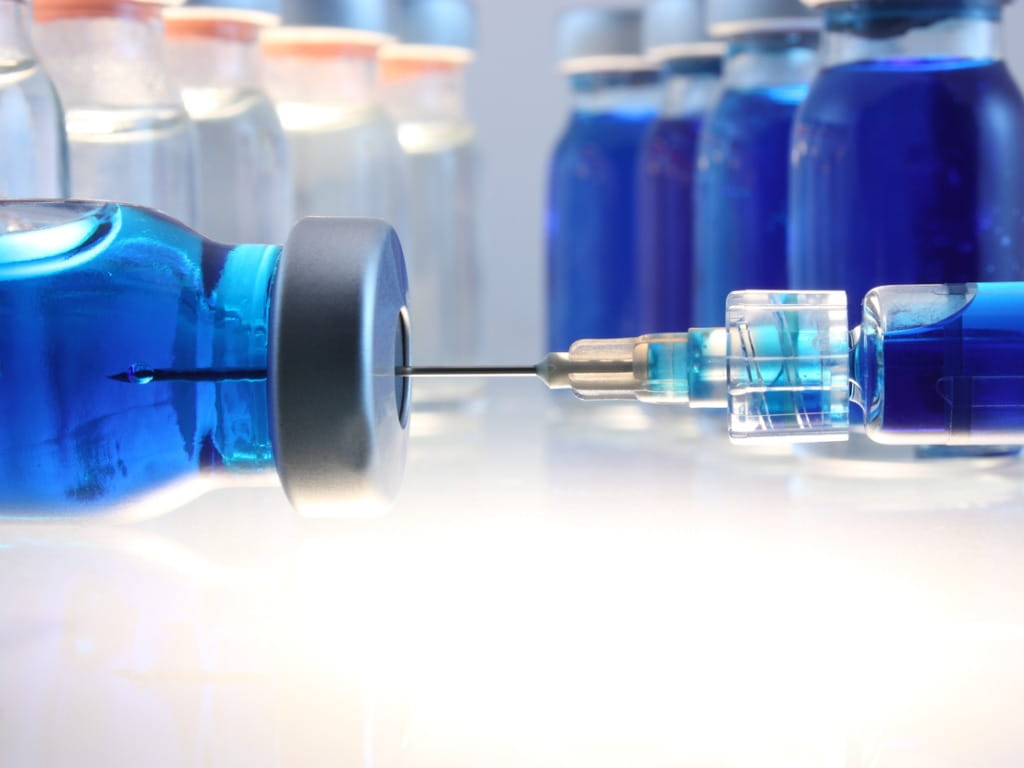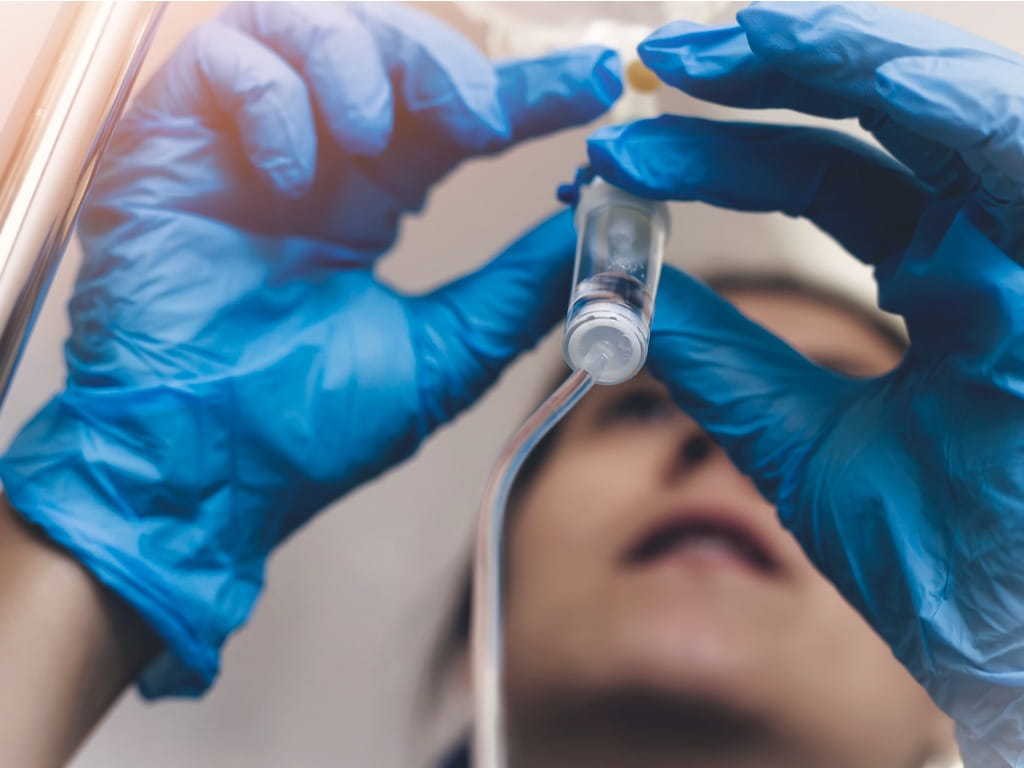Are Methylene Blue Infusions Safe?

The Bottom Line
Methylene blue is the antidote for a serious condition called methemoglobinemia but has also been studied for other medical uses. Since it has significant side effects and can interact with many medications, the routine use of methylene blue should be avoided.

What is methylene blue?
Methylene blue is a chemical that was first manufactured in 1876 as a textile dye. It was later studied as a medicinal therapy and was the first man-made medical treatment used in humans. Initially used as an antiseptic, methylene blue was subsequently prescribed as a treatment for malaria and gonorrhea.
What is methylene blue used for?
Today, methylene blue is still used as a stain or dye, but it is best known as the antidote for a serious and life-threatening medical condition called methemoglobinemia.
In methemoglobinemia, blood is not able to effectively carry oxygen to tissues, and affected patients have signs and symptoms of oxygen deprivation, including blue-tinged skin, fatigue, and shortness of breath. Methylene blue is also used to treat toxic effects of certain chemotherapy drugs as well as circulatory shock, but it is not approved by the US Food and Drug Administration (FDA) for treatment of conditions other than methemoglobinemia.
How does it work?
Methylene blue works on a cellular level within the mitochondria (the energy-producing powerhouses of cells) where it affects energy production. It might also act as an antioxidant to protect cells against oxidative stress.
Since oxidative stress is thought to hasten the aging process in humans, this means that methylene blue’s antioxidant effects could have some anti-aging activity. Methylene blue is also a photosensitizer, which means that it has increased activity when exposed to certain wavelengths of light. Light-activated methylene blue is used to treat donated blood products, as it is effective in killing some viruses, including HIV and herpes.
Can methylene blue slow down aging?
Because of its potential antiviral and anti-aging properties, some healthcare clinics offer methylene blue in formulations including skin creams and intravenous infusions to people who wish to increase longevity, stop the aging process, and prevent viral infections. While the use of methylene blue for these conditions sounds intriguing, it is important to remember that methylene blue is currently approved by the FDA only for the treatment of methemoglobinemia. The use of methylene blue to prevent aging is experimental.
There is no standard recommended human dosing for the use of methylene blue in conditions other than methemoglobinemia, and the potential health benefits of methylene blue for other conditions have not been widely studied or described in medical literature.
Methylene blue and COVID-19
Due to its antiviral activity, methylene blue has been explored as a potential treatment for COVID-19. Several studies have shown promising results for some of the complications of COVID-19 infection. However, the place of methylene blue in the management of COVID-19 infection has yet to be fully defined, and it is not approved for use against COVID-19.
Side effects of taking methylene blue
Methylene blue administration can cause blue discoloration of urine and skin and can also cause dizziness, nausea, and headache. In high doses, methylene blue can actually cause methemoglobinemia—the exact condition it is intended to treat.
Methylene blue can have adverse interactions with several medications used to treat depression, including selective serotonin reuptake inhibitors (SSRIs), serotonin-norepinephrine reuptake inhibitors (SNRIs), and monoamine oxidase inhibitors (MAOIs). These interactions can result in serotonin syndrome, which is a potentially life-threatening condition that includes rapid heart rate, fever, muscle rigidity, confusion, agitation, and seizures. In 2017, the FDA issued a warning about the dangers of using methylene blue in patients who take these medications.
Methylene blue can be harmful to a developing fetus, so it should not be taken by pregnant women. It should also be avoided by breastfeeding women. Because of methylene blue’s side effects, people should only use methylene blue after consultation with a physician who is familiar with the drug. The routine use of intravenous methylene blue should be avoided, as the risks of the drug will likely outweigh any potential benefits.
What to do if you are experiencing negative side effects from methylene blue
If someone has developed unwanted signs or symptoms after exposure to methylene blue, get an immediate personalized recommendation online from webPOISONCONTROL or call Poison Control at 1-800-222-1222. Both options are free, confidential, and available 24 hours a day.
Kelly Johnson-Arbor, MD
Medical Toxicologist
Revised William G. Troutman, PharmD
Professor of Pharmacy Emeritus
Poisoned?
Call 1-800-222-1222 or
Prevention Tips
- Methylene blue is only approved for the treatment of methemoglobinemia. Use for treating any other condition is experimental.
- Talk to your doctor before starting any new medications or nutritional supplements. All medications can potentially cause unwanted side effects.
- There is no known cure for COVID-19. Vaccination is currently the best available method to prevent infection.
- If you are pregnant or breastfeeding, talk with your doctor prior to taking over-the-counter medications, dietary supplements, or prescription drugs.
This Really Happened
A 29-year-old man with cancer and depression was given the chemotherapy drug ifosfamide. He developed confusion and hallucinations and was diagnosed with chemotherapy-related toxicity. His symptoms improved after methylene blue was administered, and additional doses of methylene blue were prescribed to prevent further chemotherapy-related toxicity. He then developed confusion, muscle rigidity, and sweating. These symptoms were initially attributed to the chemotherapy regimen but were later determined to be the result of a drug interaction between methylene blue and venlafaxine (Effexor), an SNRI antidepressant drug that he was taking. He required treatment in an intensive care unit but eventually recovered (from Gilbert & Acamune, 2020).
For More Information
Methylene blue (intravenous route). Mayo Clinic. Updated January 21, 2025. Accessed February 6, 2025.
References
Moore J. The use of methylene blue in gonorrhœa. Br Med J. 1897;1(1881):140.
Poisoned?
Call 1-800-222-1222 or
Prevention Tips
- Methylene blue is only approved for the treatment of methemoglobinemia. Use for treating any other condition is experimental.
- Talk to your doctor before starting any new medications or nutritional supplements. All medications can potentially cause unwanted side effects.
- There is no known cure for COVID-19. Vaccination is currently the best available method to prevent infection.
- If you are pregnant or breastfeeding, talk with your doctor prior to taking over-the-counter medications, dietary supplements, or prescription drugs.
This Really Happened
A 29-year-old man with cancer and depression was given the chemotherapy drug ifosfamide. He developed confusion and hallucinations and was diagnosed with chemotherapy-related toxicity. His symptoms improved after methylene blue was administered, and additional doses of methylene blue were prescribed to prevent further chemotherapy-related toxicity. He then developed confusion, muscle rigidity, and sweating. These symptoms were initially attributed to the chemotherapy regimen but were later determined to be the result of a drug interaction between methylene blue and venlafaxine (Effexor), an SNRI antidepressant drug that he was taking. He required treatment in an intensive care unit but eventually recovered (from Gilbert & Acamune, 2020).
